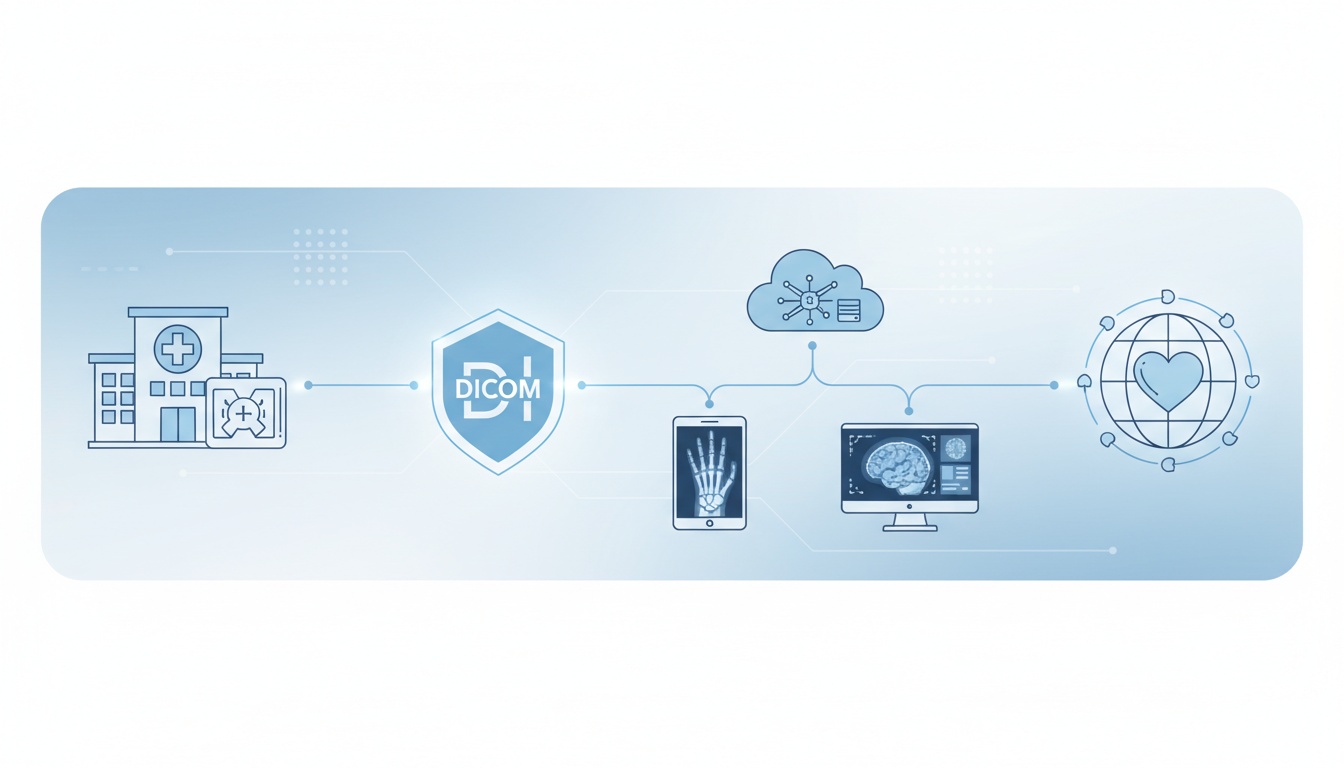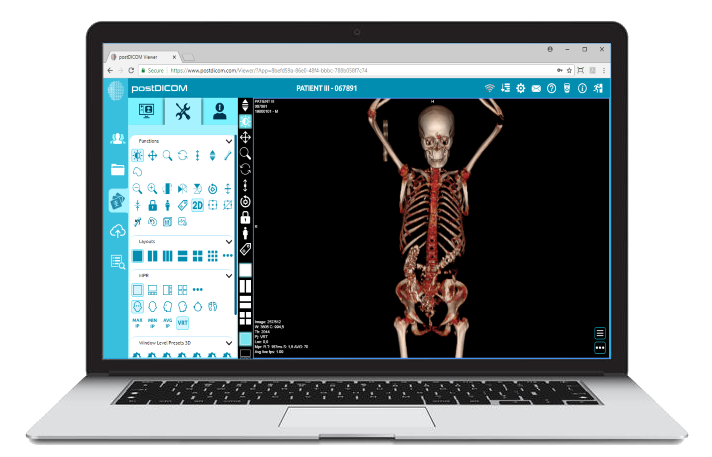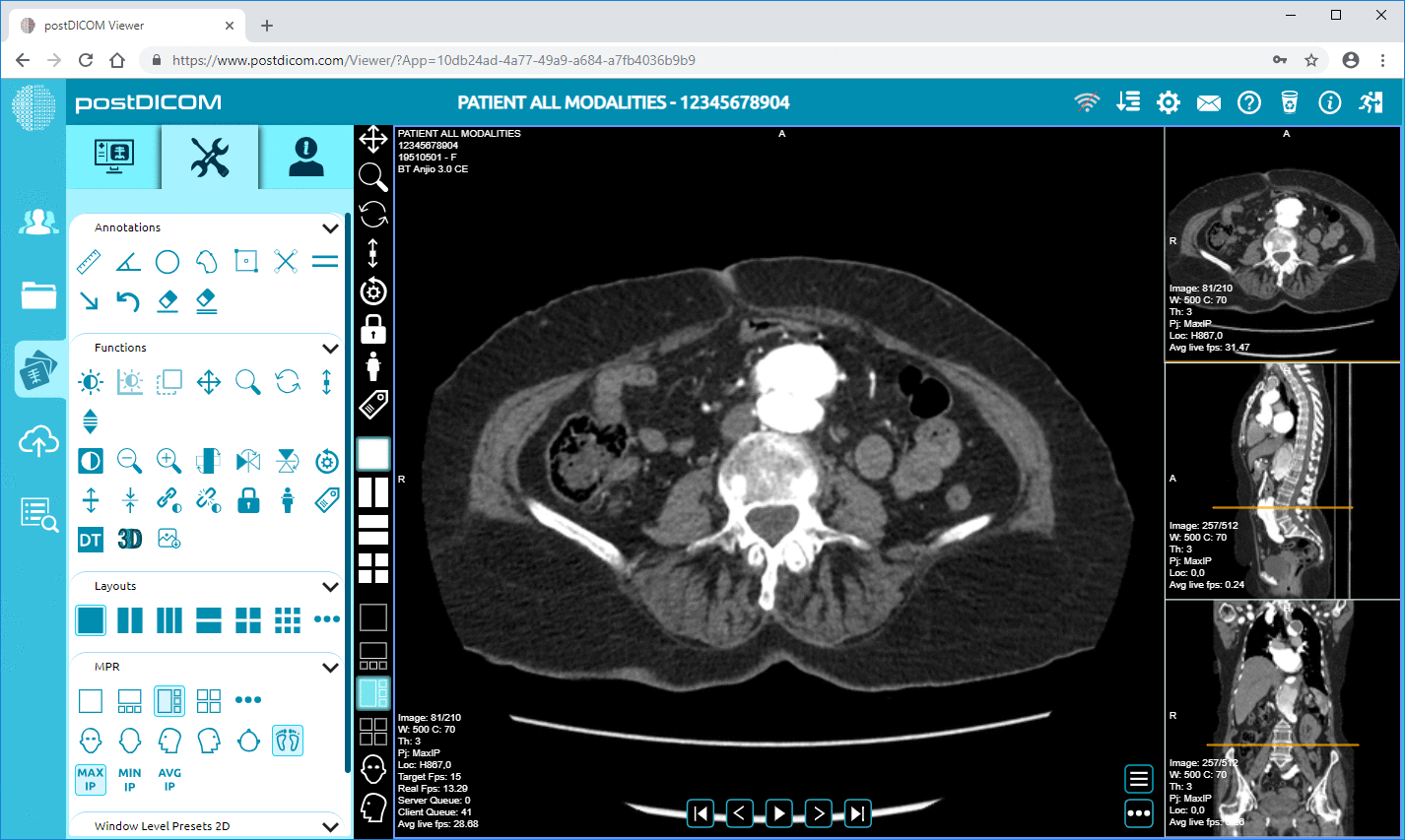
DICOM plays a pivotal role in ensuring seamless medical imaging across various healthcare settings, facilitating the exchange of diagnostic images and related data in a highly structured format. From radiology departments to cloud-based solutions, DICOM has transformed how medical images are stored, shared, and analyzed.
The advent of cloud-based Picture Archiving and Communication Systems (PACS) like PostDICOM has further revolutionized the landscape of medical imaging. By offering cloud storage solutions, PostDICOM has helped hospitals and clinics optimize their imaging workflows and improve diagnostic accuracy through faster, remote image access. Let’s dive into the significance of DICOM in radiology and its role in shaping modern healthcare.
DICOM, or Digital Imaging and Communications in Medicine, is the standard used for handling, storing, sharing, and transmitting medical images. It facilitates the integration of imaging systems with various hospital IT infrastructures, enabling consistent and efficient workflows in medical diagnostics.
Originally developed in the late 1980s, DICOM has undergone continual evolution to meet the needs of healthcare IT systems worldwide. Today, it has become the global standard for medical imaging, making it indispensable for radiologists, hospitals, and medical professionals. Whether it’s a routine X-ray, a detailed MRI scan, or a complex CT scan, DICOM ensures that images are compatible across different platforms, making it easier for healthcare providers to collaborate and deliver precise diagnoses.
The DICOM file format, with the extension .dcm, is a specialized file format used to store medical images and related data. DICOM images are distinct from other image formats like JPEG or PNG in several ways.
A key difference lies in the structure of the file. While JPEG or PNG images store only visual data, DICOM images include both the image and additional metadata, such as patient information, imaging parameters (like exposure settings or slice thickness), and the device used to acquire the image. This embedded metadata is crucial for accurate diagnostics and allows radiologists to view not just the image but also the context surrounding it.
For instance, a DICOM file for an MRI scan may contain patient details like name, age, gender, and medical history, which could be relevant for interpretation. Without this rich metadata, interpreting the image may be challenging, especially when working with large data sets.
Several other formats are used in medical imaging, but DICOM remains the industry standard due to its comprehensive capabilities:
| Format | Purpose | Limitations |
| JPEG 2000 | Compression for smaller storage | Loses crucial metadata, limiting its use in medical imaging |
| NIfTI | Neuroimaging (e.g., MRI scans) | Not widely used outside neuroscience, making it less adaptable for general radiology |
| TIFF | High-resolution images | Lacks medical-specific metadata, preventing seamless integration with PACS |
DICOM stands out because it combines high-quality imaging with detailed metadata, making it ideal for diagnostic, educational, and archival purposes. Unlike other formats that focus solely on visual representation, DICOM enables machine-to-machine communication, ensuring that imaging data can be effectively transmitted, retrieved, and analyzed within healthcare infrastructures.
The DICOM standard plays a central role in the radiology workflow. Here's a look at the typical steps:
• Image Acquisition: The first step involves capturing diagnostic images using various imaging modalities such as CT scans, MRIs, X-rays, and ultrasounds. The images are immediately stored in the DICOM format.
• Storage & Management: The DICOM images are then integrated into a PACS (Picture Archiving and Communication System), which is responsible for storing, managing, and retrieving medical images. Cloud-based PACS solutions like PostDICOM offer secure cloud storage, making it easier for healthcare providers to manage vast amounts of imaging data.
• Secure Sharing & Remote Access: DICOM enables seamless sharing of images and diagnostic data among healthcare professionals. With the rise of telemedicine, cloud-based PACS like PostDICOM allows medical professionals to access images from anywhere, improving collaboration and speeding up diagnosis.
• Image Viewing & Analysis: Radiologists use specialized DICOM viewers and AI tools to analyze medical images for abnormalities or conditions. These tools often integrate AI algorithms to aid in faster, more accurate diagnoses.
DICOM ensures seamless communication between imaging devices, PACS, and hospital IT systems. The DICOM protocol uses Message Service Elements (DIMSE), which are essential components that enable devices to exchange images and information over a network.
Key DIMSE commands include:
• C-store: Transfers medical images from one system to another.
• C-find: Allows systems to search for specific patient data.
• C-move: Transfers images to a different storage system.
Cloud-based PACS solutions like PostDICOM simplify the complexities of DICOM networking by automating these processes, reducing the technical burden on healthcare providers while ensuring HIPAA-compliant security and encryption.
PACS (Picture Archiving and Communication Systems) and RIS (Radiology Information Systems) are two systems that work hand-in-hand to manage medical imaging data. While PACS is primarily responsible for image storage and retrieval, RIS manages the workflow associated with radiology exams, including scheduling and patient tracking.
PostDICOM’s Cloud PACS solution offers seamless integration with both PACS and RIS, enabling medical institutions to streamline workflows, improve access to patient data, and enhance patient care. Cloud-based solutions like PostDICOM are also more flexible, offering scalable storage options and the ability to access medical images remotely.
 - Created by PostDICOM.jpg)
• Standardization & Interoperability: DICOM ensures consistent medical imaging across different hospitals and devices, which is essential for accurate diagnosis and patient care.
• Security & Compliance: DICOM images, when stored in a secure, cloud-based PACS solution like PostDICOM, are HIPAA-compliant, ensuring the protection of patient data.
• Efficient Image Sharing & Teaching: DICOM enables radiologists to collaborate remotely and share images with medical students for educational purposes, enhancing the learning experience.
• Scalability With Cloud Solutions: Cloud-based PACS solutions like PostDICOM eliminate storage limitations, allowing medical institutions to scale their storage needs as their image data grows.
The future of DICOM in radiology looks promising, with continued advancements in cloud-based storage, AI-powered imaging, and enhanced security protocols.
• Cloud-based Dicom Storage: As the industry moves towards cloud-based PACS solutions, PostDICOM is leading the way by offering scalable, secure storage that can be accessed from anywhere, anytime.
• Ai-powered Imaging: AI applications in medical imaging are growing rapidly. Machine learning algorithms can assist radiologists in analyzing DICOM images for patterns, speeding up the diagnostic process and improving accuracy.
• Dicomweb & Mobile Access: PostDICOM enables mobile access to DICOM images, allowing healthcare professionals to view and analyze images from their smartphones or tablets.
• Blockchain & Security: Blockchain technology is being explored to ensure tamper-proof records of medical images, adding an additional layer of security to DICOM storage.
DICOM remains the backbone of modern radiology, providing an essential framework for storing, sharing, and analyzing medical images. As the healthcare industry continues to evolve, cloud-based PACS solutions like PostDICOM are playing an increasingly vital role in improving medical imaging workflows.
If you're a radiologist, doctor, or healthcare provider looking to enhance your imaging capabilities, PostDICOM’s Cloud PACS offers the perfect solution. Experience secure DICOM storage, instant access to medical images, and seamless sharing capabilities.


|
Cloud PACS and Online DICOM ViewerUpload DICOM images and clinical documents to PostDICOM servers. Store, view, collaborate, and share your medical imaging files. |